Stem‐Changing Verbs in the Present Tense
For the verbs presented so far, the ending is what is irregular. There is, however, a different kind of predictable verb conjugation in which the stem of the verb changes and the endings are normal—even the
yo form! The stem of a verb is what is left when you remove the infinitive ending (‐ar, ‐er, or ‐ir).
Because the stem of the verb changes, these verbs are called stem‐changing verbs, or stem‐changers. You must learn each particular verb and remember that it is a stem‐changer. It is impossible to identify that a verb is a stem‐changer by simply looking at the infinitive unless you recognize a previously learned stem‐changer with a prefix.
The hardest part about stem‐changers is that you have to memorize the verbs in which stem changes occur. Once you memorize the type of stem change a verb undergoes, the actual patterns of the stem‐changing verbs are quite simple; because all the conjugation endings are regular, conjugating these verbs is easy.
For all stem‐changers, it is always the stressed syllable that changes. Stem‐changing verbs are so common that most dictionaries inform you of the stem change in the entry even before giving the verb's translation.
There are basically three different ways in which the stem of a verb can change in the present tense. The verbs listed below are grouped according to the type of stem change they undergo. When you learn the meanings of the verbs below, memorize what kind of stem change each undergoes as well.
The patterns for stem‐changing verbs are very consistent. All forms of the verb will undergo a stem change except for nosotros/nosotras and vosotros/vosotras. The best way to see the patterns is to consider a few examples.
The most common stem change is e>ie. That means the stressed letter e in the stem of the verb will change to ie in certain forms of the verb. If a verb has two e's in the stem, it will always be the second e that undergoes a stem change. In the lists and charts below, the specific e that changes to ie is underlined.
The verb cerrar is typical of an ‐ar verb with an e>ie stem change. In Table , the ie is underlined where the stem change occurs. Notice that nosotros/nosotras and vosotros/vosotras do not undergo a stem change.

All the e>ie stem‐changing verbs listed below include the stem change in parentheses after the infinitive. You should remember the verbs with the e>ie as a part of the infinitive in Spanish so that you will be able to conjugate these verbs correctly.
Listed below are some commonly used ‐ar verbs that undergo an e>ie stem change exactly like that shown in Table .

Encerrar (e>ie) (to enclose) is a good example of a basic verb that you know (cerrar) and a prefix (en‐).
The verb perder is a typical ‐er verb with an e>ie stem change. The forms of this verb presented in Table serve as an example for all the verbs listed below.

Notice that, in the verbs below, the ‐er ending is not part of the stem, so perder and querer only have one e in the stem. When verbs like defender and entender have two e's in the stem, the second one, closer to the end, will undergo a stem change. See Table for a sample conjugation chart.

The following list includes common ‐er verbs that undergo the stem change e>ie.
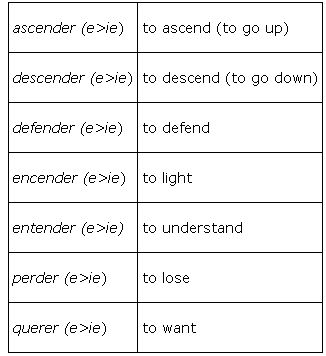
For ‐ir verbs that undergo the stem change e>ie, all follow the same patterns as the verb mentir in Table . Use this conjugation chart as an example for the forms of the verbs in the list that follows.

Some of the most common ‐ ir verbs that undergo an e>ie stem change are listed below.
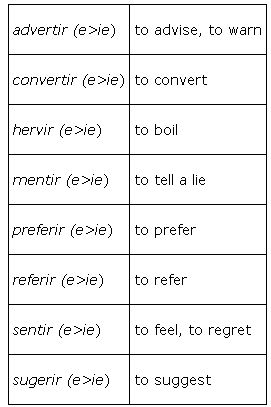
Consentir (e>ie) (to consent) is a good example of a basic verb that you know (sentir) and a prefix (con‐).
Notice that the verb preferir has two e's in the stem. Whenever there are two e's in the stem of a verb, it is the second one that undergoes a stem change. The conjugated forms of preferir are somewhat difficult to picture, so take a good look at Table that follows. When pronouncing these verb forms, remember to say every vowel.

Tener and venir are e>ie stem‐changers that also have an irregular yo form. You may remember that these two verbs were listed with the ‐go verbs under the yo irregulars. That is because the yo form of each of these verbs ends in ‐ go; the rest of the forms, however, follow the e>ie stem‐changing patterns. These verbs are very common, so be sure to learn the conjugation charts in Table and Table .

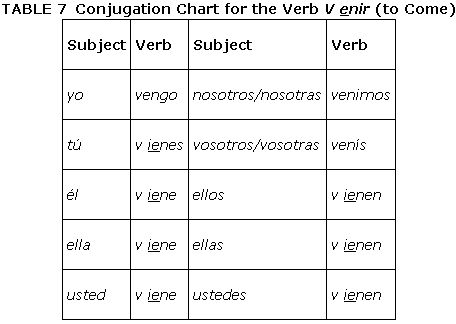
The forms for both verbs are very similar, but you should be careful to notice that the nosotros/nosotras and vosotros/vosotras endings are different for venir because it is an ‐ir verb and tener is an ‐er verb.
The second‐most common type of stem change that occurs in Spanish verbs is o>ue. Now that you understand how to conjugate stem‐changing verbs in general, learning about the verbs with an o>ue stem change will be relatively easy.
Common ‐ar verbs that undergo a stem change o>ue:

Demostrar (o>ue) is a good example of a basic verb that you know (mostrar) and a prefix (de‐). The verb demostrar is interchangeable with mostrar because they both mean “to show.”
Common ‐er verbs that undergo a stem change o>ue:
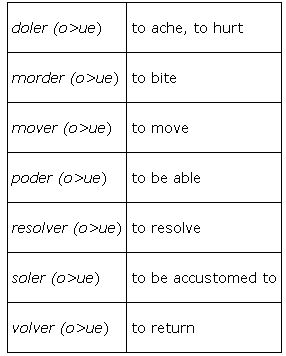
Devolver (o>ue) (to return an object, to give something back) and envolver (o>ue) (to wrap up) are good examples of a basic verb that you know (volver) and different prefixes (de‐ and en‐).
By now, you understand that a stem‐changing verb will have regular verb endings, so Table is the only example of an o>ue stem‐changer.
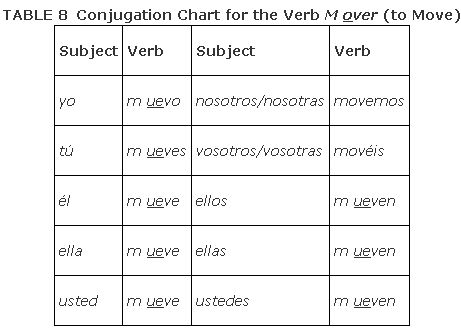
The following verbs also undergo an o>ue stem change; because they are ‐ir verbs, however, the nosotros/nosotras ending is ‐imos.
Common ‐ir verbs that stem change o>ue:
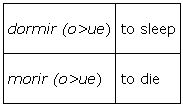
The verb jugar is usually listed with the o>ue stem‐changing verbs because it follows the same pattern. However, you may notice there is no o to change to ue in the verb jugar. It is the only u>ue stem‐changer in the Spanish language. Because it means “to play” (a sport or game), it's a popular word in both Spanish- and English‐speaking cultures. See Table for the unusual verb forms of jugar.
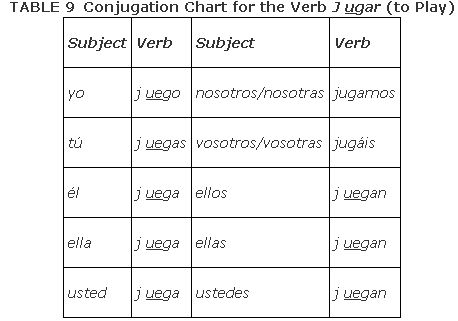
e>i stem-changers
Here's a test of your grasp of formal logic: All e>i stem‐changing verbs are ‐ir verbs, but not all ‐ir verbs are e>i stem‐changers. Consider the earlier list of e>ie stem‐changers; some of them are ‐ir verbs. This means that when you learn an ‐ir verb that undergoes a stem change, you have to be careful to remember whether it undergoes an e>ie or e>i stem change. Fortunately, the list of e>i stem‐changing verbs is short, and it is true that only ‐ir verbs can undergo an e>i stem change.
Common e>i stem‐changing verbs:

|
|
|
|
|
|
|
|
|
|
|
|
|
|
|
|
|
|
|
|
|
|
|
|
|
|
|
|
|
|
|
|
|
|
|
|
|
|
|
|
|
|
|
|
|
|
|
|
|
|
|
|
|
|
|
|
|
|
|
|